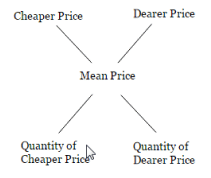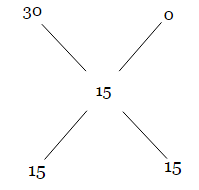Important Formulas: Mixture and Alligations | Quantitative for GMAT PDF Download
Alligation
When two ingredients X and Y of price p and q respectively are mixed together, such that the price of the resultant mixture is M (mean price), then the ratio (R) in which ingredients are mixed is given by, the rule of the alligation.
(Cheaper quantity) : (Dearer quantity) = (d – m) : (m – c)
Mixture
In a mixture, two or more ingredients are mixed together to get a desired quantity. The quantity can be expressed as ratio or percentage.
For example: When two varieties of sugar are mixed to form a new variety of sugar then it is called as a mixture.
What is a Mean Price?
- The cost of a unit quantity of the mixture is called the mean price.
Formulas to Solve Mixture and Alligations
Alligation and Mixture Formulas 1
When two commodities are mixed then , Alligation and Mixture Formulas 2
Alligation and Mixture Formulas 2
Consider a container contain x unit of liquid A from which y units are taken out and replaced by water. This operation is repeated n number of times, then the quantity of pure liquid will be given by the formula:
Alligation and Mixture Formulas 3
Calculate quantity of pure Liquid after ‘n’ successive operations,
If a container contains ‘x’ units of pure liquid , and we replace the liquid with ‘y’ units of water ,
Then after ‘n’ successive operations, the units of pure liquid left is ,
After n operations, the quantity of pure liquid 
Criss-Cross Method
Some aspirants use the above method in different format, which we call criss-cross method. Below is the format:

The working is, we take the positive difference of mean price and cheaper price and write the difference in the place of Quantity of dearer price. Similarly, take the positive difference of mean price and dearer price and write the difference in the place of Quantity of cheaper price.
Rule of Constant
There are another types of questions on mixtures and alligation where the quantity of one element in the mixture does not change while adding another element to the first mixture. For such questions, I recommend an alternate method of using the rule of constant to get to the answer. The concept uses the simple understanding of percentages.
Method 1: School textbook approach
We assume that the quantity of water added to be x litres. The quantity of milk in the existing solution is 30% of 40 = 12 litres, with the addition of water, the quantity of new solution becomes (40 + x) litres. As per the problem, the percentage of milk in new solution should be 15 %. we will get x = 40. Method 2: Rule of Alligation.
Method 2: Rule of Alligation.
We assume that the two solutions of milk and water are added to get the new solution and apply the approach we used in Example 3.
Taking milk as the common element in both the solutions, we have 30% milk in first and 0% milk in the second solution (i.e. pure water). On mixing them, we got 15% milk in the final solution. Therefore,
Or the ratio of the quantity of first and second solution should be 15:15 = 1:1
Hence, 40 litres of pure water should be mixed to get the desired new solution.
Method 3: Rule of Constant
In this rule, we target the element in the mixture whose amount does not change but its percentage changes because of the change in the total amount of the mixture.
As we calculated above, the quantity of milk in the first solution is 12 litres, and it will remain same in the new solution as well. That is,
12 liters = 30% of the first solution =15% of the new solution
|
115 videos|106 docs|113 tests
|
FAQs on Important Formulas: Mixture and Alligations - Quantitative for GMAT
| 1. What is alligation in the context of mixtures? |  |
| 2. How is alligation useful in real life scenarios? |  |
| 3. How do you solve an alligation problem? |  |
| 4. Can alligation be used for more than two ingredients? |  |
| 5. Are there any limitations or drawbacks of using alligation? |  |

|
Explore Courses for GMAT exam
|

|

















